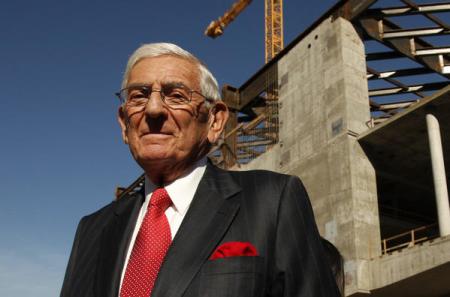Posts Tagged ‘lease’
Chapter 2 (Part 2): The Race for The Broad – A Tale of Three Cities
“I think what Santa Monica has to offer is an incredible audience, a prime location and willingness to work with the Broads.”[i] – Kevin McKeown, Santa Monica City Councilman
Within just a few months of BCAM’s opening at LACMA, rumors began to circulate that Eli Broad had been less than forthcoming about his true intentions. Contrary to his initial denial of it, at the end of 2008 local newspapers began reporting Broad intended to build a new museum for his collections in Beverly Hills.[ii] The City of Beverly Hills quickly identified a prominent parcel of land at the intersections of Wilshire and Santa Monica Boulevards for the project. An architectural competition was announced, a short list determined (Thom Mayne, Jean Nouvel, Shigeru Ban, Rafael Viñoly and Christian Portzamparc), and schematic renderings of the site plan were even published. [iii] If this speedy development seemed too good to be true, it’s because it was.
By the end of 2009, Broad announced that there were actually multiple cities vying for his collections and a new museum building to house them. Beverly Hills, previously unchallenged was suddenly competing with the City of Santa Monica, and Broad’s foundation announced there was also a third, unnamed city in the running.[iv] This of course turned out to be the City of Los Angeles. Broad said he wasn’t, “trying to play the two [three] municipalities against each other […] he hope[d] that by talking to several different cities he c[ould] accelerate the process of building.”[v] But play them against each other he did, for six months, trying to secure the best deal.
Introduction (Part 1): Public-Private Development Partnerships
It may seem unconventional to begin a thesis in arts administration by discussing a football stadium. This thesis is an exploration of urban planning in Los Angeles involving large-scale, public-private development. In the following chapters, I document how philanthropist Eli Broad’s under-construction contemporary art museum, The Broad, is being utilized to stimulate further redevelopment of an area of downtown Los Angeles called Bunker Hill. The Broad museum and the larger, coinciding Grand Avenue Project has engendered some conversation about the investment associated with public-private development projects, and the resulting public and private benefits. However, the amount of dialogue about investment and return benefit involved with the Broad museum and Grand Avenue is minimal in comparison to another large-scale, public-private development proposal less than two miles away: Farmer’s Field. The proposed downtown National Football League stadium has garnered substantial, well-publicized and in-depth political, social, and economic debate about investments and benefits. For this reason, I believe reflecting on some of the lively discussions circulating abound Farmer’s Field can be useful in introducing similar questions and concerns, which may not have been addressed or considered, or worse ignored, in the planning process of The Broad museum.
FIELD OF SCHEMES? – PUBLIC-PRIVATE INVESTMENT & BENEFIT
“We’ve built more arenas and stadiums than anyone in the world, ever–including the Romans!”[i]
– Tim Leiweke, President and C.E.O., Anschutz Entertainment Group
It is a plotline ripped from the popular television show Entourage (season 7 to be specific). Big-time developer Anschutz Entertainment Group (AEG) wants to bring the NFL back to Los Angeles. AEG’s tactic to lure a franchise to the city is to build a brand new 1.3 billion stadium in downtown. The new stadium, which AEG has already sold naming rights to, will be called Farmers Field, after the insurance company. AEG plans to squeeze the 72,000-seat stadium into the already dense LA Live—an entertainment and sports cluster, which AEG has spent more than a decade developing between the Figueroa corridor and the 110 Freeway. LA Live includes the Staples Center (home to both the Lakers and Clippers NBA franchises), Nokia Theaters, Regal Cinemas, JW Marriott and Ritz Carlton, and Grammy Museum. AEG has appealed for both public and government support of the project by communicating its record of success and by touting a lengthy list of impressive economic benefits, which AEG claims, the city would receive should the NFL return: tens of thousands of jobs, construction of nearby hotels, a revived Convention Center, and hundreds of millions of dollars in increased economic activity.[ii] The economic influence seems incalculable and the project non-negotiable.


